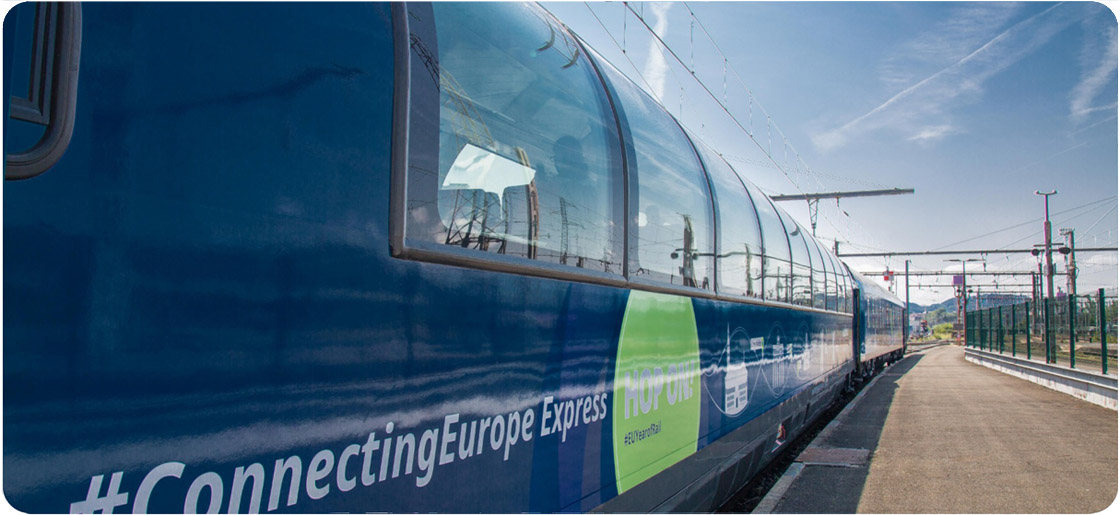 In December 2020, the European Commission presented its sustainable and smart mobility strategy. The strategy puts European transport on track to achieve a 90% reduction in the transport sector's CO2 emissions by 2050. Rail is one of the safest and cleanest transport modes, and we cannot meet our objectives without it. However, it will not work unless rail can run across borders, in a single European railway area.
In December 2020, the European Commission presented its sustainable and smart mobility strategy. The strategy puts European transport on track to achieve a 90% reduction in the transport sector's CO2 emissions by 2050. Rail is one of the safest and cleanest transport modes, and we cannot meet our objectives without it. However, it will not work unless rail can run across borders, in a single European railway area.
In 2021, we celebrated the European Year of Rail, with plenty of initiatives at local, national and European levels. The most inspiring and symbolic initiative was certainly the Connecting Europe Express which travelled over 20,000 km, visiting 26 countries, with over 100 stops and 33 border crossings. During the stops, we saw how attached local communities are to their railways, for tourism, business and, standing at the station, feeling connected to the rest of Europe.
The Year raised expectations, and we must now deliver. At the end of the year, the Commission put a powerful rail package on the table, announcing a mix of investments plans, policies and future legislation. First of all, we tabled new plans for completing Europe's transport network (TransEuropeanNetwork – Transport, TEN-T) of rail, inland waterways, short-sea shipping routes, and roads connecting 424 major cities with ports, airports and railway terminals.
On rail, we propose to allow trains to travel at 160 km/h or faster on major TEN-T passenger rail lines by 2040 and the completion of key highspeed lines by 2030.
The other part of the December package is an Action plan to boost long-distance and cross-border rail to help the EU meet its ambitious target of doubling high-speed rail traffic by 2030, and tripling it by 2050. Although the number of people travelling by train has increased in recent years, only 7% of rail kilometres travelled between 2001 and 2018 involved cross-border trips.
To encourage more people to consider the train for trips abroad, the Action plan sets out concrete actions to remove barriers to cross-border and long-distance travel, and make rail travel more attractive forpassengers. By 2030, the Commission will support the launch of at least 15 cross-border pilots to test the Action plan's approach.
In all this, we must not forget rail freight. Freight already has a strong cross-border dimension with about half of the traffic in the EU being international. The proposal for the TEN-T revision provides for better infrastructure investment planning and strengthened performance monitoring. In addition, a planned initiative on rail infrastructure management and capacity allocation will focus on providing cross-border freight with an improved use of the network, resulting in increased commercial speed, higher reliability and predictability and reduced costs for cross-border rail freight. It will challenge the current national approach to rail infrastructure capacity management and introduce a stronger EU-dimension. For this purpose, the Commission will consider the benefits and costs of an EU level entity to optimise the use of cross-border capacity and to rigorously monitor traffic performance. The initiative will also consider ways to improve the performance of rail in multimodal transport. For example, the growing container segment provides potential for achieving the mobility strategy's goal to double freight traffic by 2050.
Digital automatic coupling (DAC) contributes to modern and digital European rail freight transport. DAC increases efficiency thanks to automation of processes, ensures energy supply for telematics applications as well as safe data communication throughout the train. The Commission actively supports the European DAC Delivery Programme (EDDP), under the leadership of Europe's Rail Joint Undertaking and in cooperation with a wide range of stakeholders. The objective of EDDP is to develop, test and specify a digital automatic coupler including a migration plan and the preparation of authorisation and standardisation procedures.
Rail is already largely electrified and has a high energy efficiency. However, around 20% of train engines still run on diesel. Hydrogen and battery electric rolling stock would allow the elimination of remaining diesel operations. Such alternative fuels powered trains can bring rail to zero direct CO2 emissions, decrease air pollution, and improve rail's multimodal performances – for example, hybrid locomotives can switch from an electrified main line to an un-electrified terminal, eliminating the need for additional shunting locomotives. The Commission is fully aware of the need to replace diesel on non-electrified routes, and of eliminating diesel running "under the wires". Such routes are frequently the last mile for trains running on the TEN-T network. The development of battery, hydrogen and hybrid trains will be supported under the Europe's Rail and Clean Hydrogen joint undertakings.
The Commission believes in the green power of rail to achieve our ambitious climate targets. But rail can only be effective when borders do not matter. The single European railway area is a legal reality, but a minefield of technical, operational and administrative barriers must be eliminated to reap the full benefits. In short, if we want to make rail as green as possible, we must also mix in blue and yellow stars!
